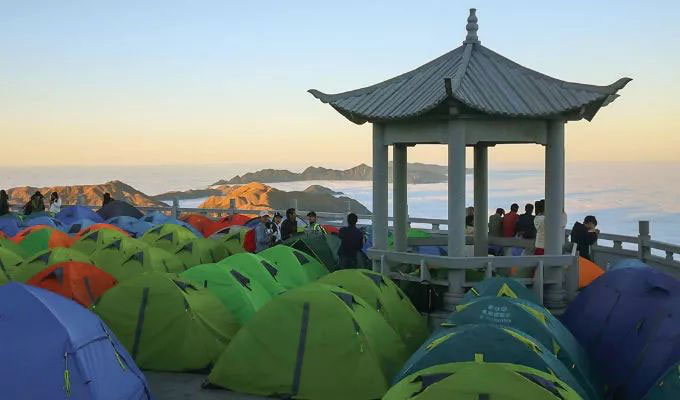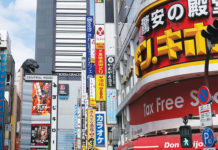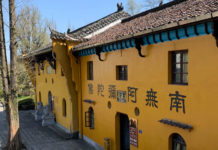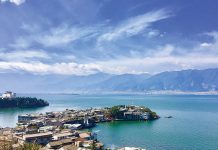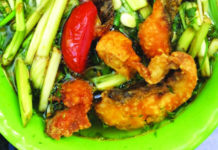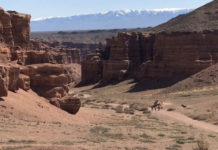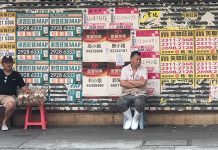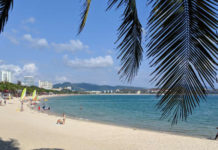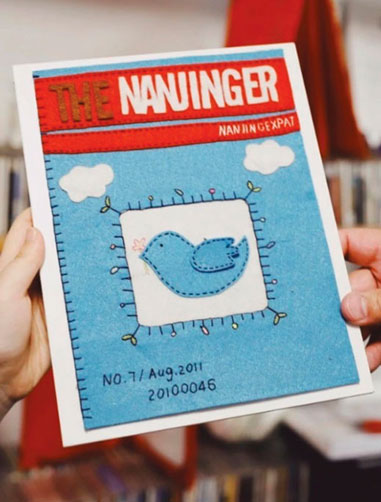It was a grey and drizzly day when we arrived at Wugongshan, so we couldn’t really understand why everyone was telling us we were lucky to see the sacred mountain that day.
Soon enough though, we would be standing atop the highest peak in Jiangxi in the sunshine, looking down on the sea of clouds.
Wugongshan is one of a chain of mountains in Northern Jiangxi province. It’s an ambitious weekend trip from Nanjing, but after our first eight weeks in China my friend Hannah and I were badly in need of some time outside the city. We chose Wugongshan because we had heard you could camp in the alpine meadows at the top of the mountain.
Before moving to China, I was aware that wild camping was something of a new concept here, but that hadn’t stopped me from stuffing all my outdoor gear into my suitcase. I’m glad I did. What we found was beautiful, memorable and certainly wild, albeit in a very Chinese sense.
Wugongshan is one of the best camping trips I’ve taken so far in China. It makes a great alternative for anyone put off by the overwhelming crowds of Huangshan or looking for a hill that can accommodate various fitness levels. You can hike the whole thing and carry your own camping gear, or take cable cars and rent a tent at the summit. However you get there, there’s an amazing view waiting for you at the top.
Getting to Wugongshan from Nanjing is easy. We boarded a 12-hour sleeper train from Nanjing on Friday night and were in Pingxiang, the nearest town to the mountain, by 10 the next morning. (There’s a 6-hour fast train as well) From there, we took a 20-minute bus ride to the base of the mountain and wandered through the typical mix of cheap restaurants and oversized, underused buildings until we found the ticket office.
Being that this was a typical Chinese-outdoors experience, there was a steep entrance fee and a tourist bus to the trailhead. We knew we had finally reached the mountain when we passed through a temple and saw endless stone steps snaking up the mountain beside a creek.
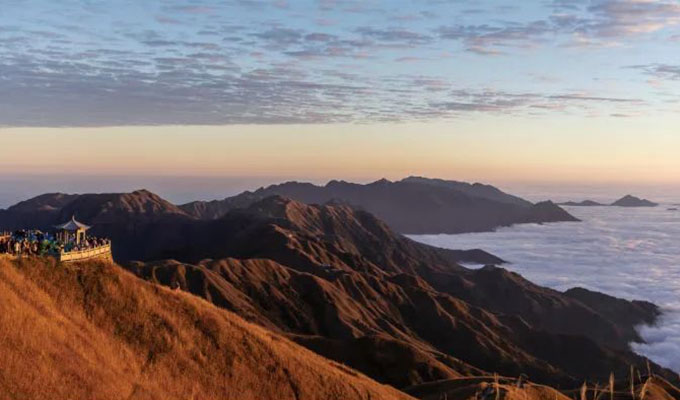
Since it was raining and already close to noon, we opted to take the first cable car. It whisked us up over a thick bamboo forest and into the clouds. From there, we followed a plank walk (complete with a rope bridge and glass balcony) towards the trail to the summit. By now, we were in the thick of the clouds and couldn’t see more than a hundred feet in front of us.
From the plank walk the trail turned sharply upward through a birch forest. This section can’t be skipped over on a cable car, so the trail was full of curious Chinese families. We were the only foreigners we saw all weekend.
After an hour or so of climbing, we reached the second cable car. It didn’t take us long to decide to treat ourselves to another lift. It was still raining a bit, and we wanted to make sure we had enough time to set up camp at the summit before dark.
Within minutes of hopping on the cable car, the clouds suddenly melted away. Blinding sunlight filled the car and we stared out in awe at the sea of clouds.
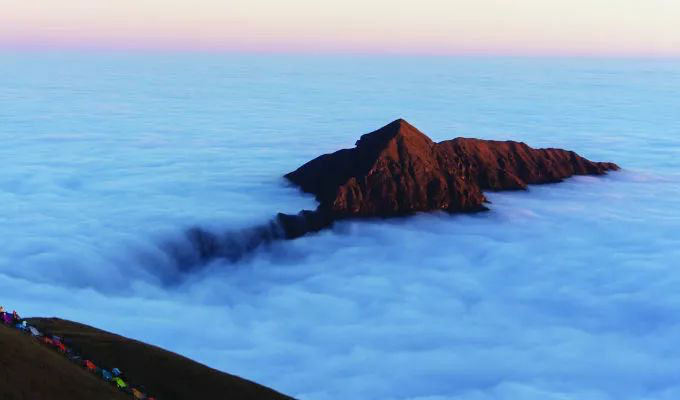
I’ve climbed in the Andes, the Canadian Rockies and the Alps. Nothing quite compares to looking down on a sea of clouds. The closest thing that comes to mind is sailing way out to sea with nothing but blue as far as you can see. Imagine that view, from 6,000 feet above. Here, it’s white clouds rippling out in every direction to the horizon.
As we climbed the last hour to the summit, Wugongshan’s last surprise materialised. Far from an empty alpine meadow, the “Golden Summit”, as it’s called, was a wooden platform already filled with colorful tents. As the sun went down, the boardwalk-style steps leading to the top filled with more and more tents.
There must have been several hundred people at the summit. There were serious hiking clubs, multi-generation families and young couples in street clothes, all settling in for a night of “wild camping” (within a few metres of a stand selling instant noodles). The atmosphere was festive and relaxed.
Hannah and I found a quiet place in the grass behind a small stone temple and pitched our tent. The clouds churned around the mountains below us as the sun sunk into the white sea. We snacked on tuna sandwiches, shared a bottle of red wine and listened as our neighbours broke out the baijiu and liar’s dice. The stars that night were the best I’ve seen anywhere in China.
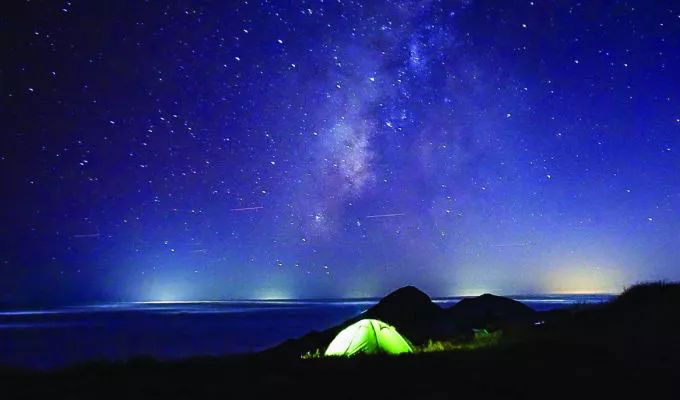
The real attraction, however, is sunrise. We were out of the tent by 5:30 the next morning, freezing and wrapped in our sleeping bags waiting for first light. It was worth the cold to watch the sun break through clouds, which hadn’t dissipated through the night.
After sunrise, we packed up and began the long, knee crushing decent back down the mountain. There’s another trail heading east off the summit that takes walkers around the second cable car, but meets up with the first one. Dramatic cliffs lead back down into the forest. We marveled at the crystal-clear water in the stream beside us.
Finally, we dragged ourselves off the mountain and back to Pingxiang station, where we boarded our train home to Nanjing, exhausted and satisfied. We had come to Wugongshan with no idea what to expect and left with a uniquely Chinese camping memory.
If You Go: Wugongshan is about 2,000 metres tall, so don’t underestimate it. Weather conditions at the top will be colder and more severe than at the base. We hiked the mountain in early November saw a major swing in temperature between night and day.
Hiking the whole mountain will take at least 4-6 hours. There are two cable cars which cut down on hiking time significantly, but there’s no way to reach the top without walking. The last stretch to the summit is straight up wooden stairs.
Being that this is a Chinese mountain experience, there are plenty of shops selling tea eggs, instant noodles and bottled water on the way up. If you’re hiking in high season when the shops are open, you can get away with buying food along the way.
When you reach the top, there are locals with tents for rent along the boardwalk. There’s also a guest house about 20-minutes west of the Golden summit on the ridge (They sell hot meals and have a fantastic deck).
There’s much more to Wugongshan than the Golden Summit. You can hike the whole ridge over several days, or continue on from the summit to another plank walk and then descend. If you have the time, the park is best explored over several days.
While it may not be uncrowded or a truly “wild” experience, this should not deter you. The mountains are beautiful and it is possible to get off the main tourist trails and enjoy nature in peace and quiet. However you do it, Wugongshan is a fantastic trip for someone looking experience the outdoors in China.


